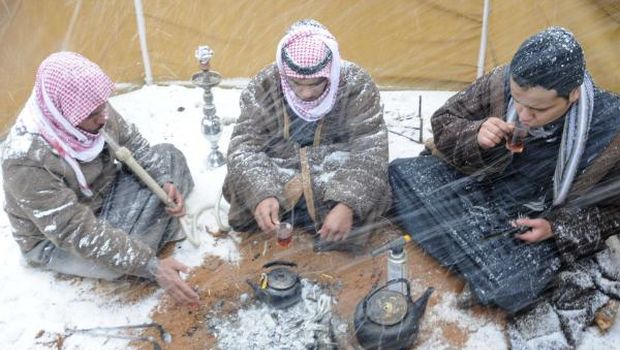
Saudi men drink tea as they sit in a tent during a snowstorm in Alkan village in western Saudi Arabia in this file photo taken on December 13, 2013. (REUTERS/Mohamed Alhwaity)
Riyadh, Asharq Al-Awsat—As soon as cold winter winds start blowing in Saudi Arabia and the Gulf countries, inhabitants rush to wear the farwa, a warm winter clothing that has accompanied the people of the Arabian Peninsula through the freezing cold for a very long time.
The farwa is a long piece of clothing that resembles the abaya in that it covers the entire body. It is usually padded with sheepskin, but rabbit hair or ostrich down can also be used. More recently, imported petroleum products from Asia have been used to manufacture faux fur, making the final product cheaper and more accessible.
Dayf Allah Al-Janouby, the chief executive of a fur and winter clothing company based in Saudi Arabia, estimated the value of the winter clothing market in the kingdom—including the farwa and the mislah—at about 320 million US Dollars. He indicated that the number of customers increased by around 85 percent as the winter cold intensified, making the season the most profitable for fur factories and import companies.
Janouby added that most of the manufacturing of fur products was carried out locally, with imported products making up no more than 45 percent.
Bandar Al-Amer, who sells winter clothing in Riyadh, told Asharq Al-Awsat that the farwa was an essential item for the Saudi winter, giving protection from the bitter cold of the desert in winter.
Fur products vary in style and quality. Amer explained that as well as those that cover the length of the body, there is another garment that only cover the torso, called a sadri. They also vary in quality and, consequently, in price.
Ibrahim Dhiab, a clothes salesman, also highlighted the variety of fur clothes and the different materials that were included in the first stages of manufacturing. Industrially manufactured faux fur is one example, which is usually aimed at female customers, and is usually decorated with traditional ornaments and trimmings.
Some of the most prominent political figures and world leaders seen wearing regional fur products include King Abdullah bin Abdulaziz, former US presidents George W. Bush and George H. W. Bush, as well as former US Secretary of State Condoleezza Rice.
Dhiab told Asharq Al-Awsat that the conflict in Syria had widely impacted the import market due to a fall in production in Syrian cities. Consequently, products manufactured in Jordan, China and elsewhere have gained popularity, competing against each other for the best combination of price and quality as demand for fur clothing increases.
